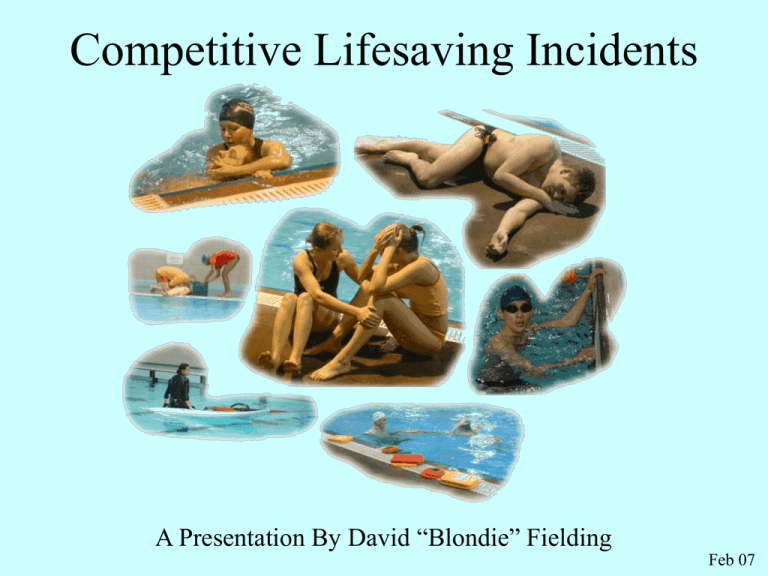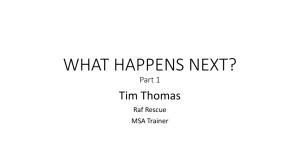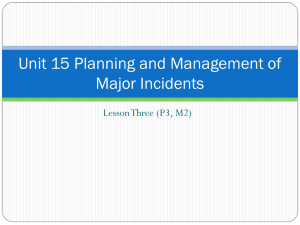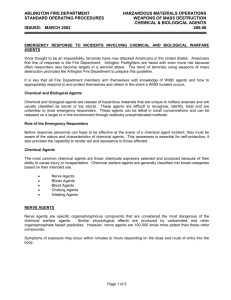Competitive Lifesaving Incidents
advertisement

Competitive Lifesaving Incidents A Presentation By David “Blondie” Fielding Feb 07 Introduction • What is a SERC? • The Rules • Back To Basics • Analysis of Mark Schemes • Winning Strategies If you have any questions as we go through, please put your hand up! What Is A SERC? • Simulated Emergency Response Competition • Multiple casualties connected in some way • Could contain: • Manikins • Bystanders • Victims • Swimmers • May evolve as you tackle it Designed to test your initiative, judgement, knowledge and abilities. What Is A SERC? • Aims of a real lifesaving incident? • To preserve life. • To obtain further qualified help without delay. X NOT NECESSARILY THE SAME THING!! X • Aims of a competitive lifesaving incident? • To score the most points in the time available. The Rules • You Need To Read The Rules! • 2 min time limit (3 min for a 50m pool) • Will be judged in accordance with RLSS Protocols • Assume the situation is “As Found” • How To Score Zero… • Take a mobile phone into isolation • Enter or rescue from “Out of Bounds” • Use non-designated equipment The Basics - Rescue Principles • Act as 4 individual lifesavers under 1 team leader • SAFETY IS PARAMOUNT! • Recognise Problem • Assess Situation • Plan a course of action • Carry out the rescue • Aftercare } } 10 secs – 1/3 of marks } 80 secs – 1/3 of marks 30 secs – 1/3 of marks The Basics - Casualty Recognition • Non-Swimmers • Weak-Swimmers • Injured-Swimmers • Unconscious Casualties The Basics - Casualty Recognition • Non-Swimmers • Desperate For Air • Vertical • Quiet • Weak-Swimmers • 45° Angle • Doggy Paddle • May Not Shout The Basics - Casualty Recognition • Injured-Swimmers • May Be LOUD! • Hold Their Injury • Unconscious Casualties • Face Down • On the surface... • …or on the bottom The Basics - Bystanders Analysis Of Marks • In a dry incident most casualties carry similar marks • Choking / CPR • Bleeding • Unconscious, Breathing • Shock • In a wet incident the following casualties carry the most marks: • Non-Breathing casualties on the side • Locked Swimmers • Non-Swimmers • In all incidents, between 25% and 50% of the marks are for captaincy, control, team-work and communication! Teamwork is what separates the good from the best! Incident Tactics - Captain • The Incident starts in isolation: brief your team! • 60% of your work is done in the first 10 Seconds! • Scan the entire area for hazards, aids, casualties and bystanders • Split the pool into sections – Deep End, Shallow End, Poolside • Make a plan (Rescuer - Aid - Casualty) • Clear Communication • Once you’ve dispatched your team it’s their job to rescue as they see fit. Incident Tactics - Team • For the first 10 seconds keep out of your captains way! • Once you’ve been allocated a casualty, carry out the rescue… • Entry (Slide-in) • Always take an aid • Swim Fast – the first 10 seconds are calm, then you need to explode into action • You only have time to go out and back once! Incident Tactics - Team • Once you’ve reached your casualty... • Tell your captain what you’ve got. • Collect your casualties to the same place on poolside. • Always treat for shock. • DO send for help but DON’T send for help too early! Incident Tactics - Recap • The Aim Of The Incident: To Get As Many Points As Possible! • 10 Secs Calm: Assess & Plan Look for aids, casualties and bystanders • 30 Secs Do the rescue Talk to bystanders, re-assess situation • 50 Secs Rescuers should have reached casualties Communicate with captain! • 30 Secs Land casualties and Aftercare Sweep the pool Send for help 4 Things To Remember… Prioritise the High Scoring Casualties! Your Safety Comes First! Always Take An Aid! Communication! Any Questions?











